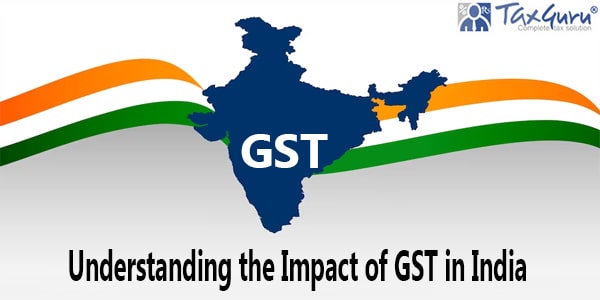Introduction: The introduction of Goods and Services Tax (GST) in India marked a significant shift in the country’s tax landscape. Implemented on July 1, 2017, after prolonged discussions, this taxation reform aimed to streamline and simplify the complex indirect tax system. In this article, we delve into the repercussions of GST on two vital sectors – Entertainment and Real Estate.
Background:
After a very long GST Discussion & Debate with enormous talks going again and again in parliament, Lok Sabha, Rajya Sabha. The most-awaited GST Taxation has been implemented in India from 1st July 2017. Earlier, Indian business units were running with basic indirect tax scheme which includes various steps and channel gates by which a taxpayer has to undergo.
The overall tax collections in India (Direct and Indirect) have amounting of Rs. 14.6 lakhs crore within this Rs. 2.8 lakh crore comes from excise and Rs. 2.1 lakh crore from service tax making a 34 percent of the indirect tax.
After the implementation of GST, the share of indirect taxes could significantly increase. GST revenue collections in April ended with a nice round number of Rs 1.03 lakh crore for the first time since its rollout last July considering the monthly average GST revenue of Rs 89,885 crore.
→ Some of the Categories Which are not Assimilated in the GST Context:
Tax on consumption and sale of electricity, customs duty and Stamp duty, amusement tax levied, etc & collected by panchayat /municipality/district council, Petroleum products.
→ There is some common objective which is aimed by GST:
- Making the Value chain stronger to ensure availability of input credit.
- To put control over extra the taxation schemes.
- Making the easy process of tax administration and regulatory compliance.
- Cutting extra numbers of tax slabs for avoiding classification complexity.
- Putting all the states into an equality proportion.
- Increasing the tax base for strictly adherence
- Creation of unified national market
- Boost to Make in India Initiative
- Boost to Investment, exports and employments

→ There are still challenges post implementation of GST which are clearly understood by these mentioned points:
- It is very hard to assume what will be the exact impact of GST in the coming future.
- No proper channel available for controlling the tax evading parties.
- Mistakenly double registration could increase compliance and cost.
- Lack of adapting the changes and implementation in proper manner.
- Spreading the relevant information & reducing the rumour about new Act
→ The GST Act applies on different Sectors of the economy are as below: –
– GST applies on Retailers, Distributor, and Manufacturing Sector, Agricultural Sector, Textile Sector, IT Sector, Banking Sector, Hotel and Tourism, Entertainment Industry, Automobile Sector, Export-Import Sector, Education Sector, Real Estate, Energy Sector, Iron and Steel, Service Sector
♦ Here we are discussing the Impact of GST on two different sectors:
– Entertainment industry
– Real estate sectors
1. Impact of GST on the Entertainment Industry
The entertainment industry is one of the GST benefit sectors. Before the implementation of GST, the entertainment sector had many taxes. They are not restricted to one tax or duty. They included the state tax, central tax, tax by the local authorities and any other industries specific taxes. However, when GST came into motion, they moved into just one tax.
Now the GST was running between 18% to 28%. The tax rate depended upon the sort of Entertainment services provided.
Things inside the 18% GST:
– Movie Tickets
– Television and DTH services
– Theatre
– Circus
Things inside the 28% GST:
– Sporting event
– Racing
– Movie events and festivals
– Amusement parks
– Casinos
2. Impact of GST on Real Estate
This sector has seen a constant growth in several years and has been a vast business area. It is an industry that is generally reliant on tax rates. Goods & Services Tax on real estate has brought more productive activities, and numerous new brands have come up.
Subsequently, these brands have been able to help the economy of the nation enormously. Therefore, this too, has been one of the sectors to benefit from GST.
What was the impact of GST on Real Estate?
Under the previous regime, if a property under construction was sold, then the following rates of taxes were applicable –
– VAT – 1 % to 4 %
– Service Tax – 4.5 %
– Stamp Duty – 5 % to 7 %
– Registration Charges – 0.5 % to 1 %
Changes in Real Estate Sector Under GST
The real Estate industry is the second biggest industry in India. GST has been significant in bringing vast improvements and solving the problems and challenges faced by the Indian taxpayers and property owners. The GST System has also been instrumental in bringing about transparency and accountability in the property and real estate business.
Since the multifarious taxes such as VAT, service taxes, etc. have been removed, the GST system has been a boon for home buyers purchasing property before its completion. Developers also had to pay excise duty, custom duty, CST, Entry Tax which was included in the cost which subsequently raised the price of the property. Post GST, the developers can now claim Input Tax Credit on the taxes paid by them which will decrease the cost for the developers and can, in turn, be passed on to the buyers.
- A GST of 5 percent will be levied on all properties with no input tax credit.
- GST will not be applied to properties after sale or ready-to-move-in buildings.
- Home buyers pay a GST of 1% for affordable housing on under construction properties like flats, houses, etc. The GST rate 2022 is 5 % for non-affordable housing.
Positive Impact of GST on Real Estate Sector
- GST simplified the complexities present under the previous taxation system and eliminated the problem of cascading of taxes.
- Many compliance issues faced by developers and sellers have been removed by a uniform tax rate under GST.
- Transparency has increased in the real estate business leading to higher trust and more ethical business practices.
- Taxes such as VAT, Service Tax, Excise Duty, Entry Tax, Octroi etc. have been removed which has consequently raised the margins for the developers by reducing construction costs, the benefit of which is passed on to the property buyers.
Rates and Applicability of GST for Various Properties
Brief look at the different Real Estate GST rates in 2022 for various properties under the Goods and Services Taxation –
Type of Property
| Type of Property | Whether GST applicable | Rate of Tax | Whether ITC Available |
| Ready to Move properties | No | No | |
| Under Construction Properties (For houses purchased under PMAY CLSS*) | Yes | 8%** | Yes |
| Under Construction Properties (other than above) | Yes | 12% | Yes |
| Sale or resale of property by 2nd owner before getting the completion certificate and not for the purpose of furtherance of business. | No | ||
| On Resale properties | No | No | |
| On buying and selling land | No | ||
| Works Contract | Yes | 18% | Yes |
| Composite Supply of Works Contract | Yes | 18% | Yes |
| Composite Supply of Works Contract to Government | Yes | 12% | Yes |
| Composite Supply of Works Contract for general public use | Yes | 12% | Yes |
| Composite Supply of Works Contract for Affordable housing | Yes | 12% | Yes |
* CLSS – Credit Linked Subsidy Scheme
** A 12% GST is levied on all properties bought under the Credit-Linked Subsidy Scheme (CLSS). However, a rate of 8% will be applied after deducting the 1/3rd amount towards the cost of land.
How it will affect the Developers, Builders and Contractors?
In the previous regime, the contractors and developers had to pay service tax for various types of services such as legal fees, labour charges, professional fees and approval fees among others. Moreover, input tax credit was not available for CST (Central Sales Tax), Customs Duty, Entry Tax. etc which increased the price of the property, which was often borne by the buyers.
The cost of construction of property is greatly reduced as now the developer can avail of ITC under GST regime.
This leads us to the next important question –
How home buyers be will affected under GST?
- The Central Government had enacted the Affordable Housing Policy in 2015 to address the housing requirements of middle- and low-income groups in India.
- In 33rd Council Meeting of GST, the GST Council decreased the GST rates from 8% to 1% for properties that are under ₹ 45 lakhs.
- Housing Schemes such as Jawaharlal Nehru National Urban Renewal Mission (JNNURM), the Rajiv Awas Yojana (RAY), the Pradhan Mantri Awas Yojana (PMAY) and other housing schemes of state governments will attract only 1% GST.
- GST is not applicable on purchase of plots.
- GST is applied on services as a part of the home loans, such as processing fees, legal fees, etc.
- Under construction properties are effectively cheaper than ready-to-move-in properties.
- A home buyer has to pay house registration charges including GST on stamp duty and registration.
- GST is not applicable on ready-to-move-in flats and only applied on under-construction homes.
- The maintenance charges will be leviable on GST on real estate only if they are more than Rs. 7500 per month per member.
GST Impact on Housing 2022
| Type of Property | Previous GST Rates (Till March 2019) | GST Rates from April 2019 |
| Affordable Housing | 8 % (ITC available) | 1% (ITC not available) |
| Non-affordable Housing | 12% (ITC available) | 5% (ITC not available) |
GST on Rented Property
If the property is rented for residential purposes, the landlord does not have to pay GST on their rental income. Now onward through the amendment in GST Act, the GST on Rental income from residential property payable by the Recipient on RCM basis, subject to certain condition. However, when the property is rented out for commercial purposes or business purposes, the GST on commercial property will be charged at the rate of 18% on forward charge basis, if the rental income is more than ₹ 20 lakhs per year.
Conclusion
The Goods & Services Tax is a milestone in India’s Indirect Tax system that addresses multiple issues together. It has brought a smoother structure to prevent double taxation. The Goods & Services Tax is destination-based tax charged at the point of consumption. Introduction of GST may have helped only some sectors to benefit from GST in the short term. But the long-term advantages are many for all the sectors
GST has proved beneficial for the real estate industry as well as its allied sectors including cement and steel industry. The new tax regime has added to the profits of property developers and contractors and has also added to the growth of the economy. Despite the prices of properties being controlled by the market forces, GST rates have had a significant role to play as explained in the article above.
Author of the Article: Hritik Kumar Shrivastava – +91 9990965841





